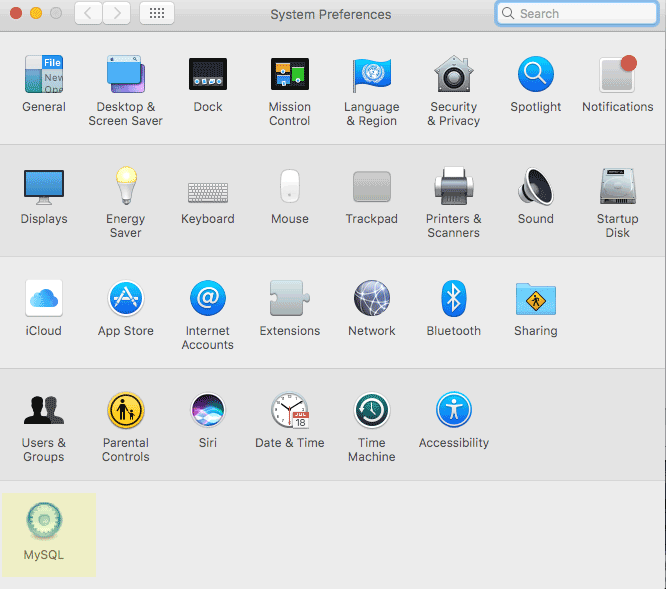I’m Dan Benjamin. I’m a podcaster, writer, and software developer based in Austin, Texas. I’m the founder of Fireside.fm, a podcast hosting and analytics platform I helped create to make podcast hosting easy, reliable, and fun. I’m also the founder of the 5by5 Studios where I get to talk to with my friends and heroes while fullfilling my lifelong dream of doing talk radio.
Setting Up Mysql Workbench On Mac
Step 2: Setting Up the Walk-In App As a business, you will always have walk-in customers, who may not be aware of the Skiplino App or just simply prefer to book their tickets in the locations. Therefore, you can set up the Walk-In App (an on-site tablet) that you can place near the main door, to allow customers to easily book for a ticket once. MySQL is a popular open source database management system commonly used in web applications due to its speed, flexibility and reliability. MySQL employs SQL, or Structured Query Language, for accessing and processing data contained in databases.
In a past life, I was a corporate stooge and eventual CTO of several startups. I've written for A List Apart and O’Reilly, made screencasts for PluralSight, and been coding for almost two decades. I co-founded a pre-Facebook social network about wine called Cork’d (acquired by Gary Vaynerchuk) and a website for parents called Playgrounder (aquired by Uncrate).
Projects
I enjoy making things that help people. Here's a list of my recent projects.
Voice Work
Hire me for voice work, narration, commercials, voice over for your videos, and more.
Setting Up Mysql Workbench On Mac
I'm available through Voices.com and for smaller projects, I'm available on Fiverr.
Dan Benjamin Live!

I do a daily morning stream with a focus on news and analysis. I also make videos teaching people how to podcast, including tutorials, gear reviews and recommendations, tips, tricks, advice, and more. I love doing this, so please like and subscribe …

Fireside
Fireside is a podcast hosting and analytics platform I created to make podcast hosting easy, reliable, and fun. I took everything I've learned as a podcaster since 2006 (and full-time at 5by5 since 2009) and built it into Fireside. It took years to build, and if you're interested in podcasting, I'd love for you to try it.

5by5
Setting Up Mysql Server On Mac
Started in 2009, 5by5 was one of the first podcast networks around. We make shows for geeks, gamers, and people like you. I host a number of shows there, and we producer about 25 total shows per week. 5by5 exists due to the generosity of our sponsors and the listeners who support us.

Podcast Method (Website and Podcast)
I love podcasting, and I love to teach people what I know about it. Podcast method is both a website and a podcast. The website lists my recommended gear and equipment, with advice about how to use it. The podcast talks in detail about these topics, and I do my best to answer listener questions each week.
Bacon Method
I love bacon but I hate mess. Fortunately, I discovered a way to make perfect, crispy bacon every time with the minimum amount of preparation and cleanup. This site teaches you how.
Table of Contents
- 2.1 General Installation Guidance
- 2.1.1 Supported Platforms
- 2.1.2 Which MySQL Version and Distribution to Install
- 2.1.3 How to Get MySQL
- 2.1.4 Verifying Package Integrity Using MD5 Checksums or GnuPG
- 2.1.5 Installation Layouts
- 2.1.6 Compiler-Specific Build Characteristics
- 2.2 Installing MySQL on Unix/Linux Using Generic Binaries
- 2.3 Installing MySQL on Microsoft Windows
- 2.3.1 MySQL Installation Layout on Microsoft Windows
- 2.3.2 Choosing an Installation Package
- 2.3.3 MySQL Installer for Windows
- 2.3.4 Installing MySQL on Microsoft Windows Using a
noinstallZIP Archive - 2.3.5 Troubleshooting a Microsoft Windows MySQL Server Installation
- 2.3.6 Windows Postinstallation Procedures
- 2.3.7 Windows Platform Restrictions
- 2.4 Installing MySQL on macOS
- 2.4.1 General Notes on Installing MySQL on macOS
- 2.4.2 Installing MySQL on macOS Using Native Packages
- 2.4.3 Installing and Using the MySQL Launch Daemon
- 2.4.4 Installing and Using the MySQL Preference Pane
- 2.5 Installing MySQL on Linux
- 2.5.1 Installing MySQL on Linux Using the MySQL Yum Repository
- 2.5.2 Installing MySQL on Linux Using the MySQL APT Repository
- 2.5.3 Installing MySQL on Linux Using the MySQL SLES Repository
- 2.5.4 Installing MySQL on Linux Using RPM Packages from Oracle
- 2.5.5 Installing MySQL on Linux Using Debian Packages from Oracle
- 2.5.6 Deploying MySQL on Linux with Docker
- 2.5.7 Installing MySQL on Linux from the Native Software Repositories
- 2.5.8 Installing MySQL on Linux with Juju
- 2.5.9 Managing MySQL Server with systemd
- 2.6 Installing MySQL Using Unbreakable Linux Network (ULN)
- 2.7 Installing MySQL on Solaris
- 2.7.1 Installing MySQL on Solaris Using a Solaris PKG
- 2.8 Installing MySQL on FreeBSD
- 2.9 Installing MySQL from Source
- 2.9.1 Source Installation Methods
- 2.9.2 Source Installation Prerequisites
- 2.9.3 MySQL Layout for Source Installation
- 2.9.4 Installing MySQL Using a Standard Source Distribution
- 2.9.5 Installing MySQL Using a Development Source Tree
- 2.9.6 Configuring SSL Library Support
- 2.9.7 MySQL Source-Configuration Options
- 2.9.8 Dealing with Problems Compiling MySQL
- 2.9.9 MySQL Configuration and Third-Party Tools
- 2.9.10 Generating MySQL Doxygen Documentation Content
- 2.10 Postinstallation Setup and Testing
- 2.10.1 Initializing the Data Directory
- 2.10.2 Starting the Server
- 2.10.3 Testing the Server
- 2.10.4 Securing the Initial MySQL Account
- 2.10.5 Starting and Stopping MySQL Automatically
- 2.11 Upgrading MySQL
- 2.11.1 Before You Begin
- 2.11.2 Upgrade Paths
- 2.11.3 What the MySQL Upgrade Process Upgrades
- 2.11.4 Changes in MySQL 8.0
- 2.11.5 Preparing Your Installation for Upgrade
- 2.11.6 Upgrading MySQL Binary or Package-based Installations on Unix/Linux
- 2.11.7 Upgrading MySQL with the MySQL Yum Repository
- 2.11.8 Upgrading MySQL with the MySQL APT Repository
- 2.11.9 Upgrading MySQL with the MySQL SLES Repository
- 2.11.10 Upgrading MySQL on Windows
- 2.11.11 Upgrading a Docker Installation of MySQL
- 2.11.12 Upgrade Troubleshooting
- 2.11.13 Rebuilding or Repairing Tables or Indexes
- 2.11.14 Copying MySQL Databases to Another Machine
- 2.12 Downgrading MySQL
- 2.13 Perl Installation Notes
- 2.13.1 Installing Perl on Unix
- 2.13.2 Installing ActiveState Perl on Windows
- 2.13.3 Problems Using the Perl DBI/DBD Interface

This chapter describes how to obtain and install MySQL. A summary of the procedure follows and later sections provide the details. If you plan to upgrade an existing version of MySQL to a newer version rather than install MySQL for the first time, see Section 2.11, “Upgrading MySQL”, for information about upgrade procedures and about issues that you should consider before upgrading.
If you are interested in migrating to MySQL from another database system, see Section A.8, “MySQL 8.0 FAQ: Migration”, which contains answers to some common questions concerning migration issues.
Installation of MySQL generally follows the steps outlined here:
Determine whether MySQL runs and is supported on your platform.
Please note that not all platforms are equally suitable for running MySQL, and that not all platforms on which MySQL is known to run are officially supported by Oracle Corporation. For information about those platforms that are officially supported, see https://www.mysql.com/support/supportedplatforms/database.html on the MySQL website.
Choose which distribution to install.
Several versions of MySQL are available, and most are available in several distribution formats. You can choose from pre-packaged distributions containing binary (precompiled) programs or source code. When in doubt, use a binary distribution. Oracle also provides access to the MySQL source code for those who want to see recent developments and test new code. To determine which version and type of distribution you should use, see Section 2.1.2, “Which MySQL Version and Distribution to Install”.
Download the distribution that you want to install.
For instructions, see Section 2.1.3, “How to Get MySQL”. To verify the integrity of the distribution, use the instructions in Section 2.1.4, “Verifying Package Integrity Using MD5 Checksums or GnuPG”.
Install the distribution.
To install MySQL from a binary distribution, use the instructions in Section 2.2, “Installing MySQL on Unix/Linux Using Generic Binaries”. Alternatively, use the Secure Deployment Guide, which provides procedures for deploying a generic binary distribution of MySQL Enterprise Edition Server with features for managing the security of your MySQL installation.
To install MySQL from a source distribution or from the current development source tree, use the instructions in Section 2.9, “Installing MySQL from Source”.
Perform any necessary postinstallation setup.
After installing MySQL, see Section 2.10, “Postinstallation Setup and Testing” for information about making sure the MySQL server is working properly. Also refer to the information provided in Section 2.10.4, “Securing the Initial MySQL Account”. This section describes how to secure the initial MySQL
rootuser account, which has no password until you assign one. The section applies whether you install MySQL using a binary or source distribution.If you want to run the MySQL benchmark scripts, Perl support for MySQL must be available. See Section 2.13, “Perl Installation Notes”.
Instructions for installing MySQL on different platforms and environments is available on a platform by platform basis:
Unix, Linux, FreeBSD
For instructions on installing MySQL on most Linux and Unix platforms using a generic binary (for example, a
.tar.gzpackage), see Section 2.2, “Installing MySQL on Unix/Linux Using Generic Binaries”.For information on building MySQL entirely from the source code distributions or the source code repositories, see Section 2.9, “Installing MySQL from Source”
For specific platform help on installation, configuration, and building from source see the corresponding platform section:
Linux, including notes on distribution specific methods, see Section 2.5, “Installing MySQL on Linux”.
IBM AIX, see Section 2.7, “Installing MySQL on Solaris”.
FreeBSD, see Section 2.8, “Installing MySQL on FreeBSD”.
Microsoft Windows
For instructions on installing MySQL on Microsoft Windows, using either the MySQL Installer or Zipped binary, see Section 2.3, “Installing MySQL on Microsoft Windows”.
For details and instructions on building MySQL from source code using Microsoft Visual Studio, see Section 2.9, “Installing MySQL from Source”.
macOS
For installation on macOS, including using both the binary package and native PKG formats, see Section 2.4, “Installing MySQL on macOS”.
For information on making use of an macOS Launch Daemon to automatically start and stop MySQL, see Section 2.4.3, “Installing and Using the MySQL Launch Daemon”.
For information on the MySQL Preference Pane, see Section 2.4.4, “Installing and Using the MySQL Preference Pane”.
